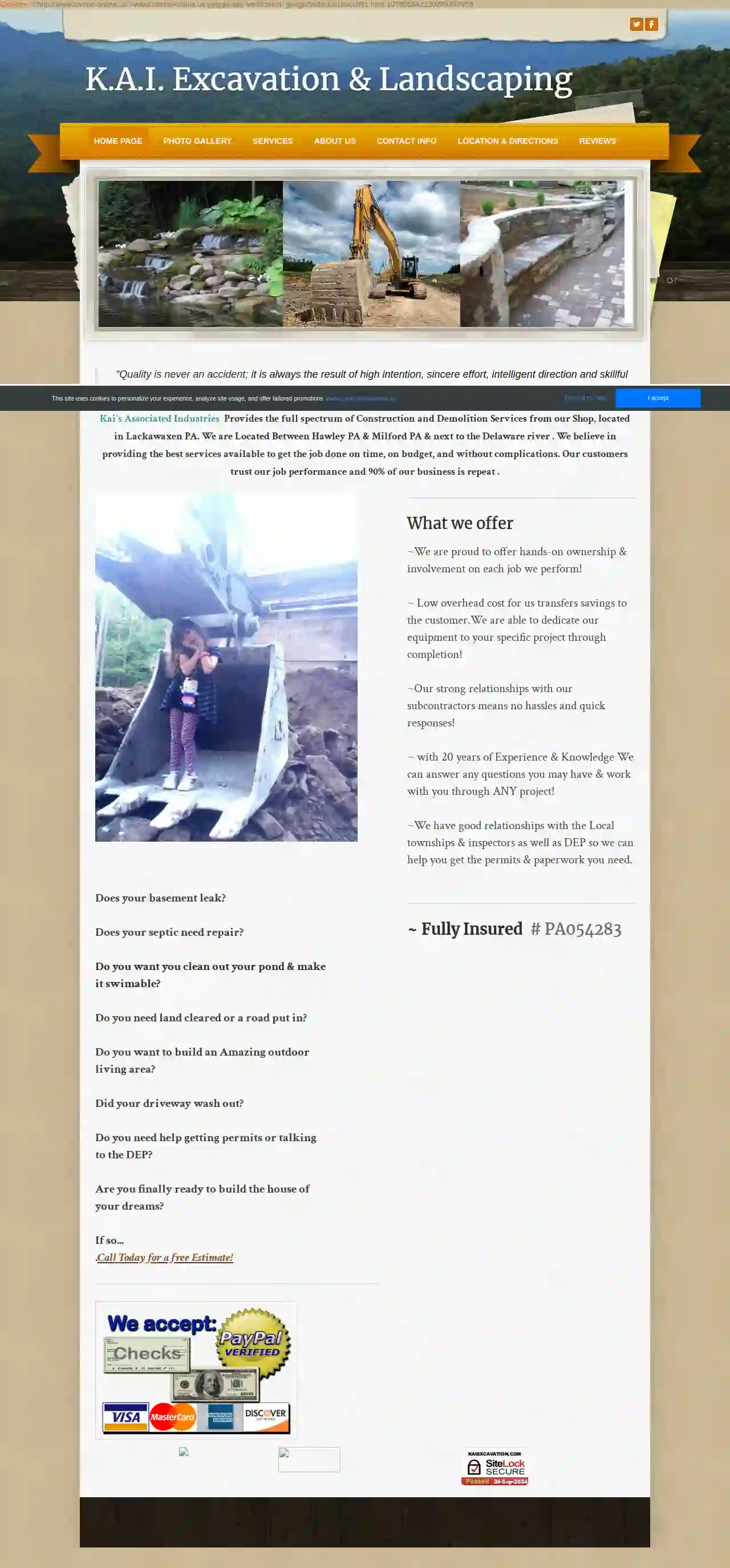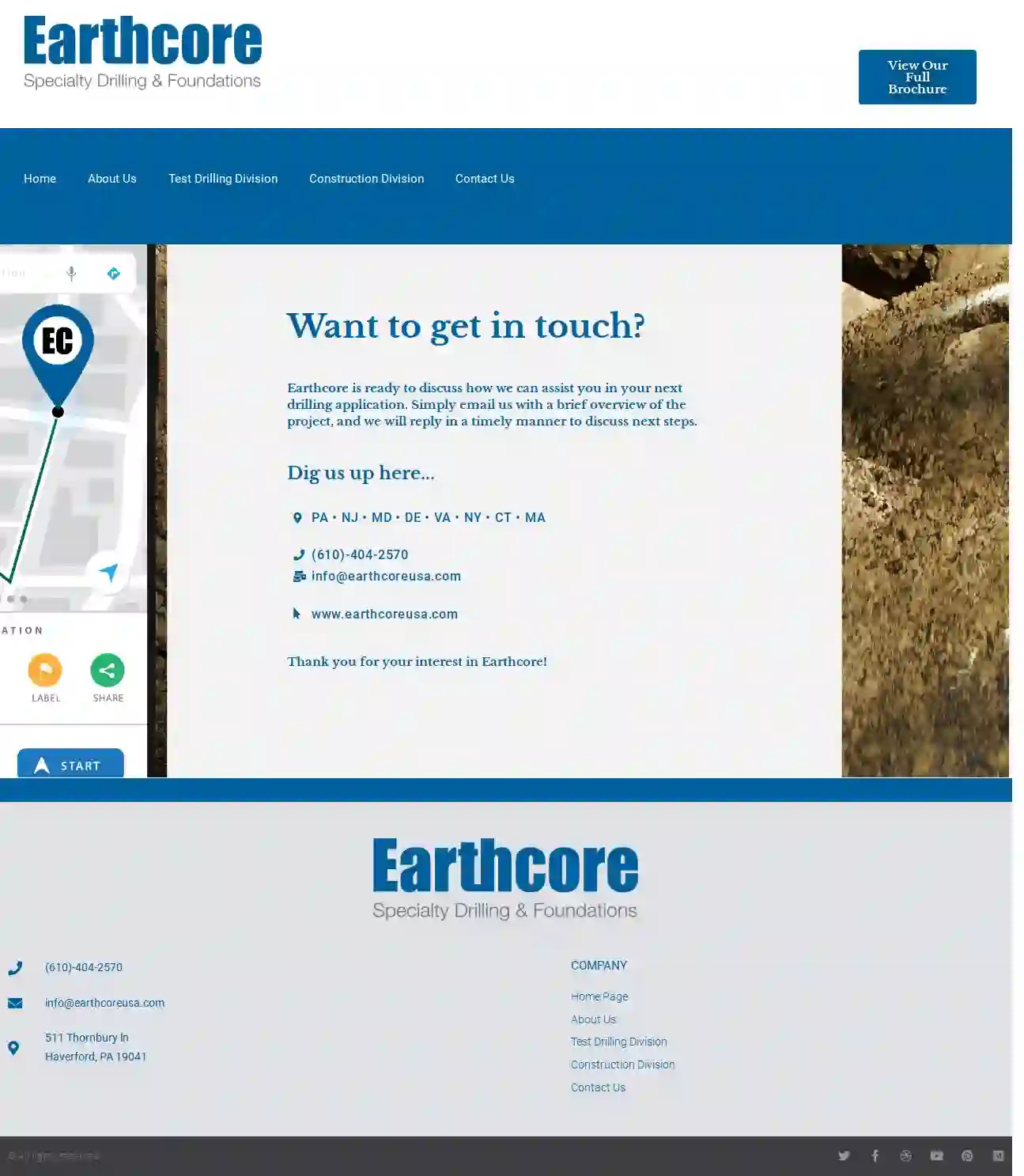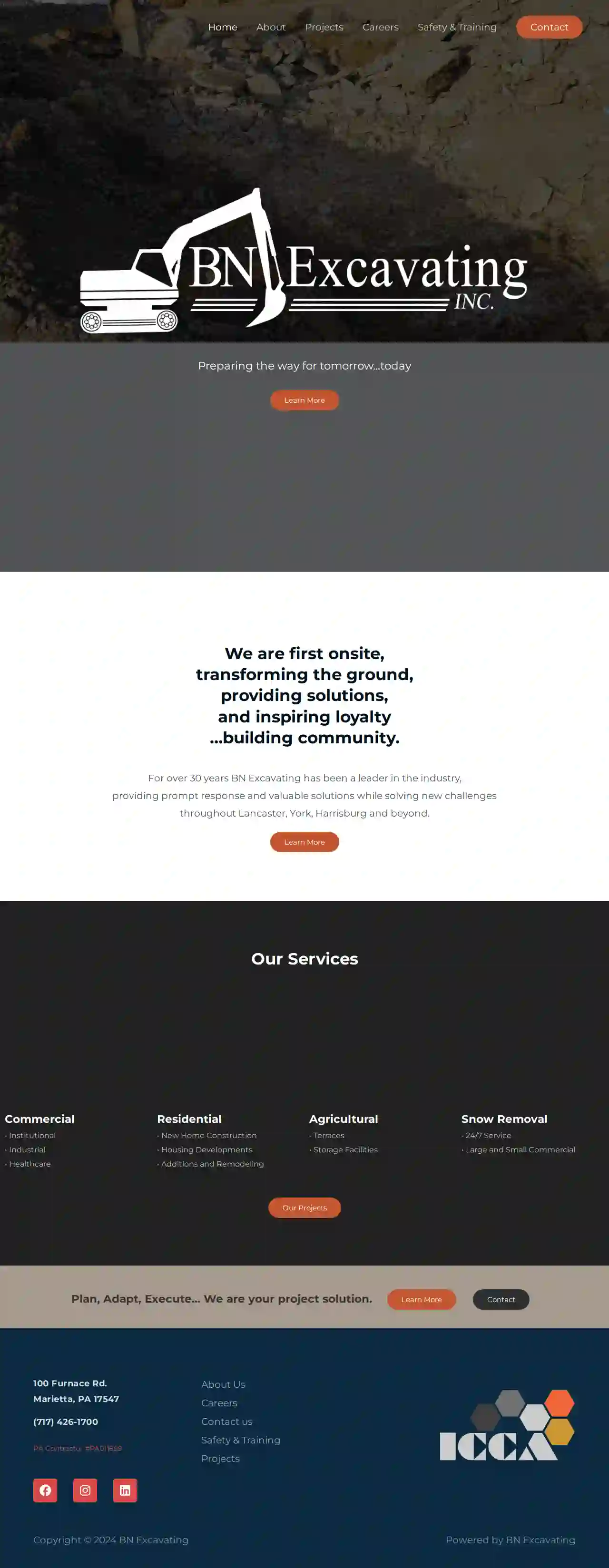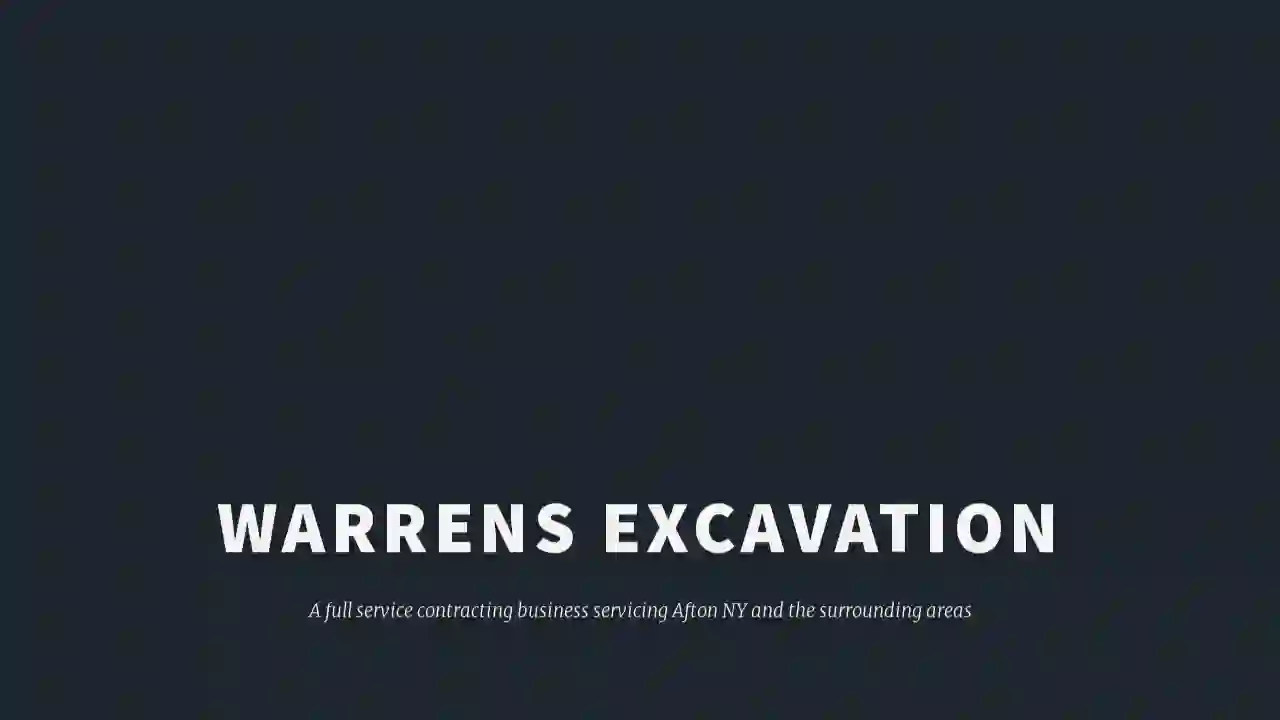Excavation Contractors Breinigsville
Best Excavating Contractor in Breinigsville
Get multiple Trenching Services quotes for your project today! Compare profiles, reviews, accreditations, portfolio, etc... and choose the best deal.

K.A.I. Excavation & Landscaping
4.423 reviewsLackawaxen, USAbout Kai Wicksnes /Owner Operator When did you start your business? I started working in the landscaping /Excavation field right out of High School in 1995. I worked with Heavy Equipment since I was old enough to reach the lever's & Petals. My Best Friend Growing up had a Father in the Excavation business and I learned a lot from him at a very young age. I also came from a long line of hard working men with good work ethics. My dad taught me that learning new trades and learning about the Land was crucial to being a well rounded man. I had a natural proclivity and passion for Excavating & Landscaping since I was a young boy. Before I had my drivers licence neighbors would see me driving my bike with a cart behind it carrying a lawn mower, gas & a rake in tow. Soon I had a small business in the neighborhood and it has grown into what it is today. I have always loved seeing the end result of my work. It gives me great pride to take an area so rough & tumble & make a beautiful waterfall with a pond with free land to run on. What makes you different than other similar businesses in your community? I live in the area that I work ,so I do the best work possible to keep my clients(who are usually my neighbors) happy. I like to drive past a job I did and see kids running in the lawn I created or people sitting around a stone fireplace I built. It is very important to me to continue building a top notch business for my children to someday run. I want Kai's Associated Industries to be known for our great customer service & excellent work. I also have a lot of my own land so I get the majority of my materials right from my property. I am able to REUSE a lot of resources such as tree stumps which we bury until they biodegrade back into the soil. Being very cautious with any land & it's animals, I consider all option's while clearing a large portion of forest. We are a small family business with a big presence With over 20 years of experience & am very knowledgeable about what I do. I am now building a family who is also into landscaping & excavating. From creating landscapes, to operating machinery, to advertising, and book work. I am looking forward to my children working with me & continuing the well established business I poured my heart and soul into. I am a firm Believer that a Family that works together, Stays together . I look forward to see
- Services
- Why Us?
- Gallery
Get Quote
ES Excavation
56 reviewsESExcavation.com, Newtown Square, Pennsylvania, 19073, USExcavation Contractors serving Southeast PA If you are a residential or commercial customer in Southeast PA and the surrounding region, ES Excavation is here to help anytime you need someone to dig in the dirt. We are a full-service excavating contractor, and can also provide you with landscape design and storm water solutions. We aim to complete each of our projects in an efficient and cost-effective way. We don’t cut corners and we always take proper precautions to prevent any potential problems and dangers while striving to ensure that the project is complete on time and under budget. We take the time to meet with all of our clients to ensure that every project is completed to their standards. Providing us with your vision, goals and timeline allows us to do our job even better. Every client we meet and do business with is satisfied with our work. That’s because we work with you, and have a genuine interest in achieving your project goals.
- Services
- Why Us?
- Gallery
Get Quote
Earthcore
11 reviews455 Fairview Chapel Road, Birdsboro, 19508, USFor decades, engineers, contractors, and property owners alike have come to rely on Earthcore as the go-to resource to resolve their toughest drilling and foundation construction challenges. Headquartered in Birdsboro, PA, we deploy our crews across the Northeast and Mid-atlantic regions. With a proven track record of documented safety, certifications, and successful execution, Earthcore brings highly-experienced operators and a large, diverse fleet of powerful rigs to job-sites rapidly to get the job done right. We invite you to do a little digging of your own to learn how Earthcore may be the perfect solution for your project. Be it test borings, soil stabilization, or assistance with specialty foundation construction, we do it all.
- Services
- Why Us?
- Gallery
Get Quote
ESPJ CONSTRUCTION CORP.
4.966 reviewsYork, USESPJ Construction: Your Vision, Our Expertise ESPJ Construction has been serving residential accounts for over 20 years, establishing ourselves as a trusted full-service construction and masonry company. We specialize in transforming ordinary outdoor spaces into stunning works of art, using our craftsmanship and experience to elevate your property. Our expertise extends to a wide range of services, including: Blue Stone Colored Concrete Concrete Pavers Concrete Resurfacing Concrete Sealing Pervious Concrete Stamped Concrete Stamped Concrete Resurfacing We are passionate about creating beautiful and functional outdoor living spaces, whether it's a cozy patio, a private seating area, an outdoor kitchen, or anything else you can imagine. Our team of skilled artisans is dedicated to delivering exceptional results that exceed your expectations. We are proud to be a family-owned and operated business, committed to safety, quality, and customer satisfaction. We believe in building strong relationships with our clients, and we are always happy to answer any questions you may have. Contact us today to learn more about our services and how we can help you realize your residential construction and landscaping goals.
- Services
- Why Us?
- Our Team
- Gallery
Get Quote
Four Bridges Construction & Renovations
131 Main St, Staten Island, 10307, USAbout Four Bridges Construction & Renovations At Four Bridges, we are residential and commercial contractors serving Staten Island and the Tri-State Area. We bring a unique blend of vision and experience, both as building designers and builders, allowing us to offer valuable insight and advice to help you design your dream home, remodel, or addition. We handle site development, planning, zoning, and navigate any hurdles you might encounter in your building project. We stay abreast of the latest construction trends to ensure your project is built with the highest quality and efficiency. Let our years of experienced designing and building work for you.
- Services
- Why Us?
- Gallery
Get Quote
Strouse Excavating and Landscaping
56 reviewsHarrisburg, USRF Strouse Landscape Excavate: Your Trusted Partner for Excavation, Landscaping, and Winter Services in Mount Wolf, PA We pride ourselves on providing exceptional services to residential and commercial clients throughout Mount Wolf, PA. With a commitment to quality, safety, and customer satisfaction, we offer a comprehensive range of services to meet all your property maintenance and improvement needs. From expert excavation to stunning landscape design and reliable winter services, we are your go-to solution for transforming and maintaining your outdoor spaces.
- Services
- Why Us?
- Gallery
Get Quote
RR Plumbing Roto-Rooter
4.8978 reviewsStaten Island, USStaten Island Plumbers Near You Plumbing & Drain Solutions: Licensed Staten Island Plumber Providing 24/7 Emergency Plumbing and Drain Services If you are currently looking for a reputable plumber in Staten Island that can meet your plumbing needs quickly and correctly the first time, then look no further. For over 85 years, RR Plumbing Roto-Rooter has been skillfully meeting the plumbing and drain cleaning needs of homes and businesses throughout the entire Staten Island, NY area. Our licensed and insured plumbers can handle commercial, residential, and emergency plumbing and drain cleaning needs of all sizes and complexities, including toilet repairs, blocked sinks, clogged shower drain repairs, sump pump replacements, and water heater installations. Our affordable plumbing services are also available 24/7 so that you do not have to wait to get the solutions you need.
- Services
- Why Us?
- Testimonials
- Gallery
Get Quote
Bayside Excavation & Hauling
522 reviewsMillington, USBayside Excavation & Hauling: Your Trusted Partner for Excavation and Hauling Services in Millington, MD Bayside Excavation & Hauling is a leading provider of excavation and hauling services in Millington, MD, serving Caroline, Kent, Queen Anne's, and Talbot counties. With decades of experience and a commitment to excellence, we offer a comprehensive range of services to meet your needs, whether you're a homeowner, contractor, or business owner. Our team of experienced professionals is dedicated to providing personalized service and high-quality results. We understand that every project is unique, and we work closely with our clients to ensure that their needs are met. We are committed to safety, efficiency, and customer satisfaction. What sets us apart? **Decades of Experience:** Our team boasts over 100 years of combined experience, ensuring that every project benefits from seasoned insights, innovative solutions, and unparalleled skill. **Comprehensive Services:** We offer a wide range of services, including excavation, hauling, land clearing, demolition, and septic system installation and repairs, providing a one-stop solution for all your excavation and hauling needs. **Personalized Approach:** We prioritize personalized service tailored to each client's unique needs and project specifications. From initial consultation to project completion, we work closely with clients to understand their objectives, offer expert advice, and deliver results that exceed expectations.
- Services
- Why Us?
- Gallery
Get Quote
BN Excavating Inc
4.512 reviews100 Furnace Rd., Marietta, 17547, USPreparing the way for tomorrow…today We are first onsite, transforming the ground, providing solutions, and inspiring loyalty…building community. For over 30 years BN Excavating has been a leader in the industry, providing prompt response and valuable solutions while solving new challenges throughout Lancaster, York, Harrisburg and beyond. BN Excavating is a family-owned and operated business with a commitment to quality, safety, and customer satisfaction. We are dedicated to providing our clients with the highest level of service and expertise. Our team of experienced professionals is committed to delivering projects on time and within budget. We are proud to serve the Lancaster, York, Harrisburg and surrounding areas. We are committed to providing our clients with the highest level of service and expertise. Our team of experienced professionals is committed to delivering projects on time and within budget. We are committed to providing our clients with the highest level of service and expertise. Our team of experienced professionals is committed to delivering projects on time and within budget.
- Services
- Why Us?
- Accreditations
- Our Team
- Gallery
Get Quote
Warren's Excavation & Stone
51 reviews10000 10th Line, Tavistock, N0L 1P0, USWarren's Excavating: Your Trusted Partner for Excavation Services Warren's Excavating is a family-owned and operated business with over 20 years of experience in the excavation industry. We are committed to providing our clients with high-quality, reliable, and affordable services. Our team of experienced professionals is dedicated to exceeding your expectations and delivering exceptional results. We understand that every project is unique, and we take the time to listen to your needs and develop a customized plan that meets your specific requirements. Whether you're looking for site preparation, foundation excavation, utility installation, or any other excavation service, we have the expertise and equipment to get the job done right. At Warren's Excavating, we pride ourselves on our commitment to safety, quality, and customer satisfaction. We use only the latest equipment and techniques to ensure that your project is completed on time and within budget. We also offer free estimates and competitive pricing. Contact us today to learn more about our services and how we can help you with your next excavation project.
- Services
- Why Us?
Get Quote
Over 22,076+ Excavation Contractors on our platform
Our excavation contractors operate in Breinigsville & surroundings!
ExcavationHQ has curated and vetted the Best Excavation Companies near Breinigsville. Find the most trustworthy pro today.
Frequently Asked Questions About Excavation Contractors
- Utility Locates: Contact your utility companies to mark the locations of underground lines before excavation begins. This is usually a free service.
- Hand Digging: Excavate carefully by hand near marked utility lines to avoid damage.
- Potholing: Digging small test holes to expose and verify utility depths and locations.
- Safe Distances: Maintaining a safe distance between excavation equipment and marked utility lines.
- Vacuum Excavation: Using vacuum excavation techniques to expose utilities without digging, reducing the risk of damage.
- Clearly Define the Scope: Outline the project's goals, including the excavation area, depth, grade, and intended use.
- Obtain Necessary Permits: Research and acquire any required permits from your local authorities.
- Mark Utility Lines: Contact your utility companies to locate and mark underground utilities to prevent damage.
- Communicate with Neighbors: Inform your neighbors about the project's timeline and potential noise or disruptions.
- Prepare the Site: Clear any obstacles, such as vegetation, furniture, or structures, from the excavation area.
- Discuss Safety Protocols: Review safety procedures with the contractor to ensure a safe work environment.
- Soil Type and Stability: Stable, cohesive soils allow for deeper excavations than loose or unstable soils.
- Groundwater Level: Excavations below the water table require dewatering techniques to manage water intrusion.
- Equipment and Resources: The size and capabilities of excavation equipment influence the achievable depth.
- Safety Regulations: OSHA and other safety regulations impose limitations on trench depths without proper shoring or sloping.
- Project Requirements: The purpose of the excavation (basement, pool, foundation) determines the necessary depth.
How do you protect utilities during excavation?
What should I do before excavation starts?
What is the difference between cut and fill excavation?
Cut: Involves excavating soil from an area where the existing grade is higher than the desired grade.
Fill: Refers to using the excavated soil ('cut' material) to raise the grade in an area where the existing grade is lower than desired.
This method minimizes the need to import or export soil, reducing costs and environmental impact. It's commonly used for site preparation, road construction, and landscaping.
How deep can you excavate?
How do you protect utilities during excavation?
- Utility Locates: Contact your utility companies to mark the locations of underground lines before excavation begins. This is usually a free service.
- Hand Digging: Excavate carefully by hand near marked utility lines to avoid damage.
- Potholing: Digging small test holes to expose and verify utility depths and locations.
- Safe Distances: Maintaining a safe distance between excavation equipment and marked utility lines.
- Vacuum Excavation: Using vacuum excavation techniques to expose utilities without digging, reducing the risk of damage.
What should I do before excavation starts?
- Clearly Define the Scope: Outline the project's goals, including the excavation area, depth, grade, and intended use.
- Obtain Necessary Permits: Research and acquire any required permits from your local authorities.
- Mark Utility Lines: Contact your utility companies to locate and mark underground utilities to prevent damage.
- Communicate with Neighbors: Inform your neighbors about the project's timeline and potential noise or disruptions.
- Prepare the Site: Clear any obstacles, such as vegetation, furniture, or structures, from the excavation area.
- Discuss Safety Protocols: Review safety procedures with the contractor to ensure a safe work environment.
What is the difference between cut and fill excavation?
Cut: Involves excavating soil from an area where the existing grade is higher than the desired grade.
Fill: Refers to using the excavated soil ('cut' material) to raise the grade in an area where the existing grade is lower than desired.
This method minimizes the need to import or export soil, reducing costs and environmental impact. It's commonly used for site preparation, road construction, and landscaping.
How deep can you excavate?
- Soil Type and Stability: Stable, cohesive soils allow for deeper excavations than loose or unstable soils.
- Groundwater Level: Excavations below the water table require dewatering techniques to manage water intrusion.
- Equipment and Resources: The size and capabilities of excavation equipment influence the achievable depth.
- Safety Regulations: OSHA and other safety regulations impose limitations on trench depths without proper shoring or sloping.
- Project Requirements: The purpose of the excavation (basement, pool, foundation) determines the necessary depth.

